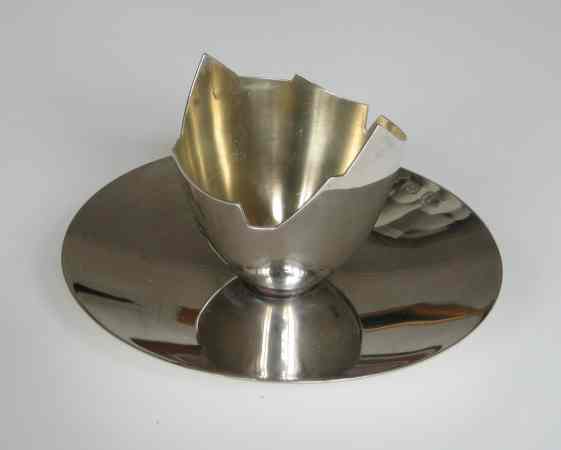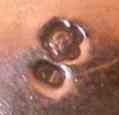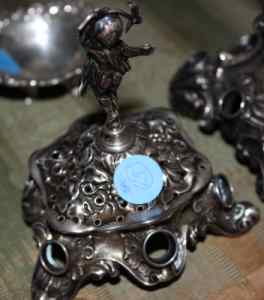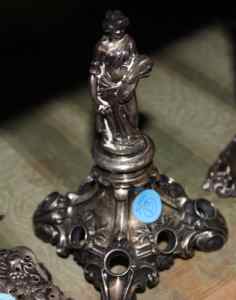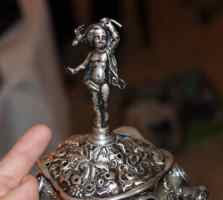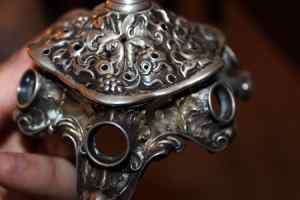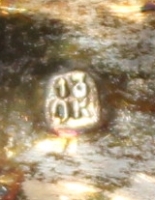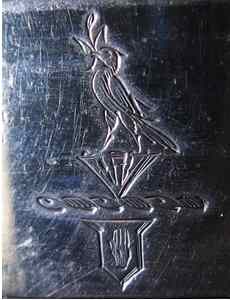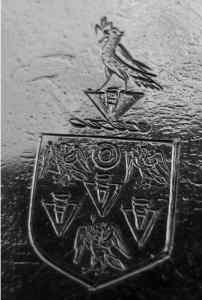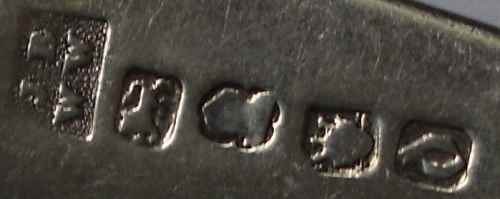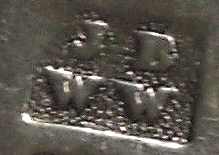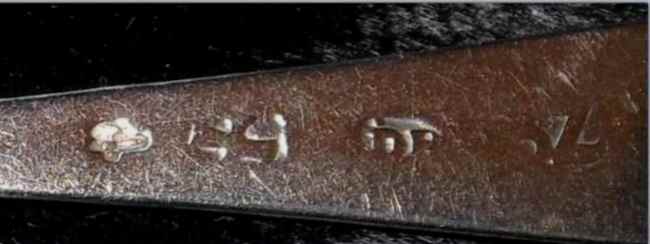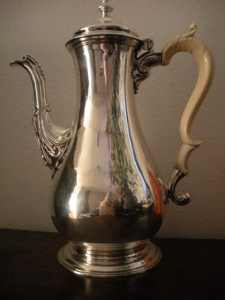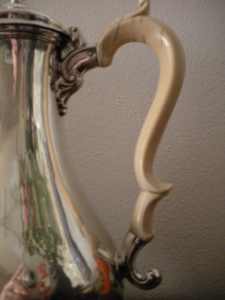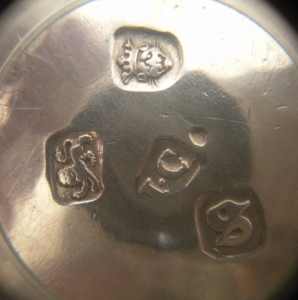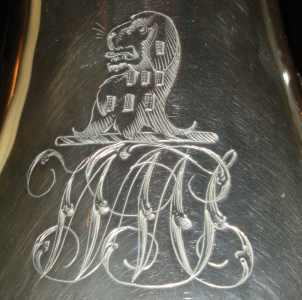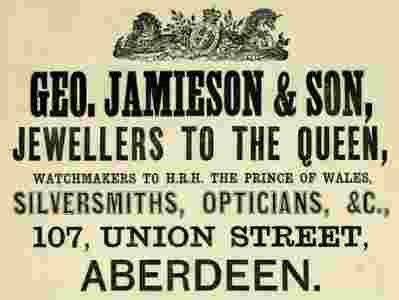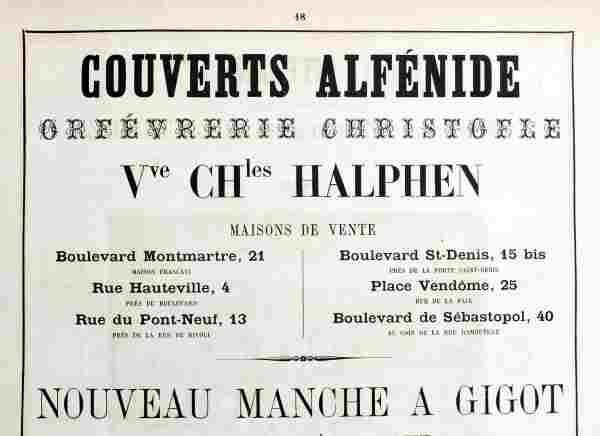
David N. Nikogosyan presents:
Marks of French silver-plated cutlery in the XIXth
century
Marks of Christofle, Veuve Charles Halphen,
Gombault-Desclercs and Manufacture de l'Alfénide

So far I was not interested by the marks of
silver-plated cutlery. However, the early pieces of
Christofle cutlery seem to be remarkable. First of all,
they are excellently designed. Second, they are
convenient, beautiful and robust. Third, they are
self-documented, as every piece is marked by its year of
production. And, fourth, they are world-wide spread. It
should be reminded that around 1844 the Christofle
company pioneered the mass production of silver-plated
cutlery and continued until at least 1930. As a result
nowadays you can find Christofle cutlery from the XIXth
century practically everywhere on the globe, in any
antiques shop or on any flea market. In addition, many
other French and foreign jewellery firms, producing
silver-plated cutlery, copied the pieces of Christofle
cutlery. I can easily mention a dozen of European
jewellery firms, issuing silver-plated cutlery "à la
Christofle cutlery", amongst them the French firms
Ercuis, Halphen, Desclercs, Frenais, the German
companies WMF, August Wellner Soehne, Bohrmann, Hartmann,
Henniger, the Austro-Hungarian factories Arthur Krupp
Berndorf, Herrmann, the Russian foundries (situated in
Warsaw) Fraget and Norblin and many others.....
click here

|
Welcome to new ASCAS members:
Claudette Barber - USA
Stuart Bennett - England UK
Lois Clausen - USA
Nikita Demidov - Belarus
Gary D. Gardner - USA
Andrea Gaveli - Switzerland
Robin Gibson - Australia
Brain King - England UK
Guido Manescotto - Italy
Sue Peggram - England UK
Mike Schaper - USA
Valerie Steptoe - England UK
Ole Lachmann writes:
English or Austrian design?
Three examples of the egg cup on the photo have appeared in the
English antique trade. All with Hukin and Heath marks for
Birmingham 1895-96. It is an astonishing modern design for a
piece of Victorian English silver. Hukin and Heath made a range
of silver designs by Christopher Dresser, but this is made later
and it is not really his style - in fact is seems more
mid-twentieth century design than any of Dressers designs.
I have had much fun from asking other collectors and museum
people to date it without looking at the marks - and so far all
guesses have been in the range 1912-1960.
Much to my surprise the same design - identical to the last
detail of the broken egg-shell - appeared at an Austrian auction.
Measures were identical but the weight of the English examples
was 73 g and the Austrian example was 64 g.
In the Austrian example the egg shell part was marked with the
dog mark for small articles of silver fineness 800 in the period
1886-1922 and the saucer part (firmly welded to the eggshell
part) was marked with the Diana head for silver fineness 800 for
the same period. The makers mark is KB in a rectangle with
rounded corners (see the poor photo below), which (from Waltraud
Neuwirth's book) I believe is Karl Bubeniczek working in Vienna
from 1894.
The Austrians made very clean designs in silver in the 19th
century.
Has any reader information that can tell whether this
surprisingly modern design is originally English or Austrian and
how it happens to appear in identical versions in the two
countries?
Regards
Ole Lachmann
Pierre P. writes:
...I'm trying to identify these marks on two pieces of French
flatware.
Any help would be highly appreciated
Pierre P.
The first mark is for GRASSE 1783. Grasse is a small town in
the extreme South-East in France, in the Provence region.
Detailed marks:
- G 83 is the warranty mark for Grasse 1783,
- silversmith is Joseph SACHE (mark JS) who was registered in
1781 and died in 1787,
- other marks are tax marks used in the region between 1781 and
1789: the A is a "charge" mark (tax declaration) and the small
rose bud is a "discharge" mark (tax payment). These marks are
normally dedicated to small silver items.
The second mark is, presumably, the single mark doubled and
observed with initials ABL, a bishop's miter and a crowned fleur
de lys belongs to the silversmith Alexandre Bernard LEBLANC who
was registered in Paris in 1763.
Leblanc left Paris 3 years later in 1766 without giving notice
for his departure, he was then declared "absent" (away) and
there is no information about his new location for pursuing his
activity where he kept the same mark, probably working with the
"abonné" status (i.e. paying a lump tax), which implies there to
punch his mark twice.
Sorry I do not know the corresponding location and for these
explanations that may appear somewhat "trying" or confusing.
Christophe Ginter
Anneliese M. Scherring writes:
...I have two pieces that I would like to post photos of on your
site to see if anyone can tell me what they are.
Both are similar but the smaller one with the putti top has
small holes (like I'd expect to see on a toothpick holder) but
also has large holes around the base (were there possibly inset
stones removed from there???) and the larger of the two pieces
with the Greek female figure on top only has the large holes.
Both are marked with what looks like the numbers "13" over "OK"
but the marks are very hard to make out!
Any help would be greatly appreciated!
Thank you,
Anneliese M. Scherring
Kari Helenius writes:
... I attach pictures of two engravings on two different 17th c.
beakers
The left one is on the upper rim of a beaker made in Augsburg
1673.
The one on the right hand side is on the bottom of an unmarked
Russian beaker.
Basically the bird itself is the same in both cases. Both are ca
5 mm high.
The main difference is on the coat of arms/crests below the bird.
I believe that these engravings are much later than the beakers.
Do you have any idea about these crests?
Best regards
Kari Helenius
The crest on the left refers to an Augsburg 1673 beaker, while
that on the right belongs to an unmarked 17th century beaker (stopa)
made in Russia
The crests look like English/British family crests. Note the
striking similarity with that of Arkwright family in the "Crest"
column in this newsletter. But similar crests were used by many
others families and the main difference are the triangular
device on which is resting the bird.
Giorgio Busetto
Giovanni Ciceri, Graham Hodges, Robert Massart, Karin
Sixl-Daniell and John Yale write
The mark JB over WW was entered for York by James Barber &
William Whitwell. Jackson's Silver and Gold Marks show this mark
used from 1812 onwards. Their partnership ended on death of
William Whitwell in 1823.
Christophe Ginter, Janjaap Luijt and Robert Massart write
The Dutch fork of David Boddy has the marks of the town of
Zutphen in Gelderland (the Netherlands) province (the cross),
the year letter 5Z = 1774 (or 6Z = 1799). The makers mark is
hard to read.
further information are added by Peter van Oel
1.) the hatchet, the 1853 duty mark for old silver objects
of national origin returned to the trade. In accordance with
several resolutions with further clarifications, this mark was
intended for objects with the hallmarks of the ancient
Netherlands silversmiths' companies...
The use of this mark was abolished in 1927 for two reasons:1st,
The lack of knowledge of the old marks has caused this mark to
be sometimes struck on old foreign objects. 2nd, this mark had
often been counterfeited and used to give objects an antique
aura.
2.) Cross (cross pattée) guild city mark for the Dutch city of
Zutpen.
3.) Maker's mark DB: no good match found
4.) 6Z date letter, Zutphen 6th alphabet letter Z for 1799-1807.
Giovanni Ciceri writes
The date letter is for London 1773/74.
It is likely that the maker is John Carter II. About the
registration date consider what reported by Jackson (1) in the
chapter "Chronological list of names of London Goldsmiths" of
his "English Goldsmiths and their marks". He warns to be careful
with the date of registration of a silversmith marks because
they may have been in use one of two years before registration
(1) Charles J. Jackson, 1964. English Goldsmiths and their marks
- A history of the goldsmiths and plate workers of England,
Scotland and Ireland. Second Edition. Dover Publications Inc.,
New York.
Giovanni Ciceri
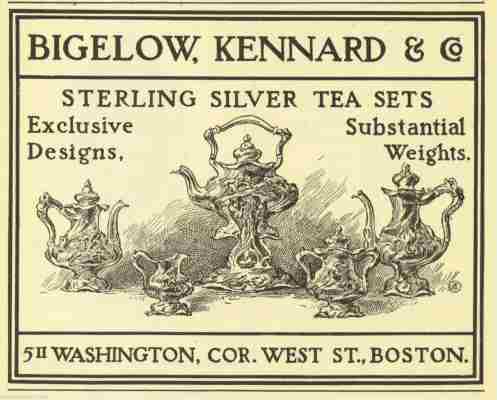
|
This month ASCAS presents an ancient advertisement
of:
BIGELOW, KENNARD & CO
STERLING SILVER TEA SETS
5 WASHINGTON, COR. WEST.ST., BOSTON
The firm was founded in 1830 in Boston (State Street) by
John Bigelow. Soon afterwards John was joined by his
brother Alanson, changing the name to Bigelow & Company.
Later entered in the business Abraham O. Bigelow (brother),
M.P. Kennard, William H. Kennard and F.P. Bemis and the
name was changed to Bigelow, Kennard & Co. In 1869 the
firm moved to Boylston Street, Boston.
After the death or retirement of the original partners,
Alanson Bigelow Jr. became sole proprietor and was
joined in 1895 by his son Alanson Bigelow (the third
member of the family with the same name).
Another son (Homer Lane Bigelow) entered in the
partnership (in 1899, retiring some years later) and
afterwards entered a son-in-law (Reginald C. Heath).
The business was incorporated in 1912 and went out of
business in 1922
This image is part of the
ADVERTISEMENTS IN SILVER - SILVER ADVERTISING
section of www.silvercollection.it website
|
"A WORD per MONTH"
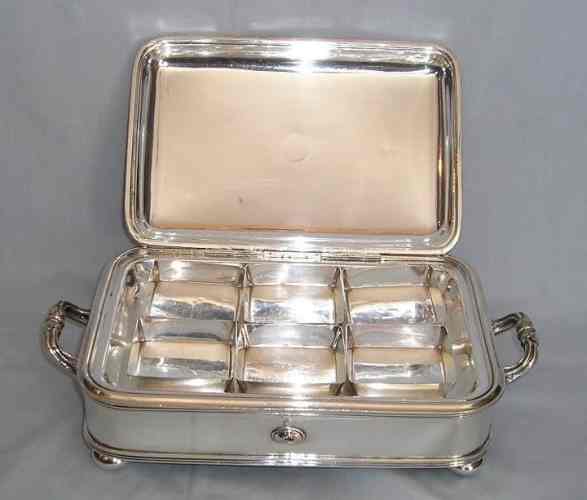
|
CHEESE TOASTER
TOASTED-CHEESE DISH
Among the innovation of the last quarter of the
eighteenth century were specialized dishes for melting
cheese on toast. Usually the inside of the dish is
divided up into sections with six to twelve small
removable pans.
The "cheese toaster" is equipped with a hot-water
compartment. As was the case with the vegetable dishes,
the hot water could be poured into the jacket of the
dish by unscrewing the handle or lifting up a small cap
at the side....
more
|
"A SILVERSMITH per MONTH"
|
|
GEORGE JAMIESON - GEORGE JAMIESON & SON - JAMIESON &
CARRY
George Jamieson was the son of
William Jamieson, an Aberdeen silversmith.
He completed his apprenticeship in 1841 succeeding to
his father who died in the same year and in 1862 he
participated as exhibitor to the 1862 International
Exhibition (presenting in the section Works in Precious
Metals, and their imitations and Jewellery: granite and
pebble ornaments) .
Jamieson acted also as retailer of silverware
manufactured by Hayne & Cater of London and often his
mark (GJ) accompanies their "SH over DC" mark.
In 1875 his son William George Jamieson was admitted
into the Aberdeen Hammermen and entered in partnership
with his father (but the mark WGJ accompanies that of
his father in a London 1872 hallmark) under the style
George Jamieson & Son (since 1848 the firm was active at
73 Union Street, Aberdeen and from 1867 at 107, Union
Street). The firm was maker of "Granite ornaments and
Scotch Jewellery, Crest Brooches, Highlands Ornaments
and agent for Elkington & Co."
In 1881 William Whyte Carry entered in the partnership,
becoming sole proprietor in 1908.....
more
|
"A CREST per MONTH"
ARKWRIGHT
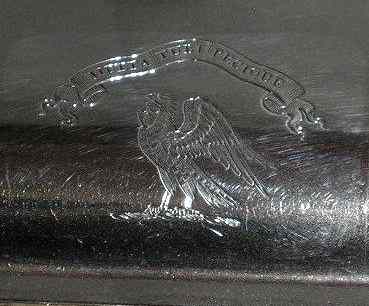 |
A crest used by Robert
Arkwright, Esq. of Sutton Scarsdale and Willersley,
Derby.
The crest is described as "an eagle, rising (in beak an
escutcheon, pendant by ribbon, charged with a hank of
cotton)".
The motto is "Multa tuli fecique" (I have borne and done
many things)
The crest was found on an Old Sheffield Plate cheese
toaster made by H: Wilkinson & Co.
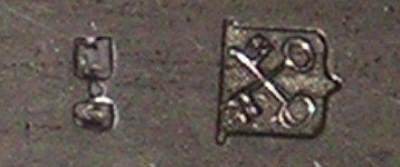
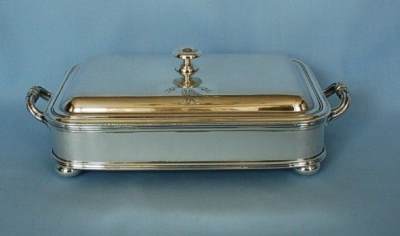 |
Closing our MARCH 2014 edition of
ASCAS Newsletter I hope you have appreciated its content.
Your comments, suggestions and advice will be of great help.
My thanks to
Christophe Ginter, Kari Helenius, Graham Hodges, Ole Lachmann,
Janjaap Luijt, Robert Massart, David N. Nikogosyan, Pierre P.,
Anneliese M. Scherring, Karin Sixl-Daniell and Peter van Oel for
their precious contributions.
Giorgio Busetto
Secretary
DISCLAIMER AND PRIVACY POLICY
ASCAS is a community of people having a common
interest in antique silver.
It is a non-profit association without commercial links.
Membership is open to whomever has a true interest in
this subject matter.
ASCAS has no real property and no fees are requested nor
accepted from members.
ASCAS keeps in touch with its members only through
periodical newsletters, e-mails and web-site updating
and ignores and is not responsible for any other
activity pursued by its members.
Likewise, ASCAS is not responsible for opinions,
evaluation and images displayed, and in any form
published or supplied for publication, by its members
who, in any case, maintain the property of their works
and assure the respect of national and international
legislation about Intellectual Property.
ASCAS does not have the full addresses of its members (only
town, country and e-mail address are requested for
membership).
ASCAS handles and protects with care its members' e-mail
addresses, will not disclose the addresses to third
parties, will use this information only to reply to
requests received from members and for communications
strictly related to its activity.
These rules are expressly accepted by submitting the
membership request.
|
|
 newsletter
# 118 March 2014
newsletter
# 118 March 2014









